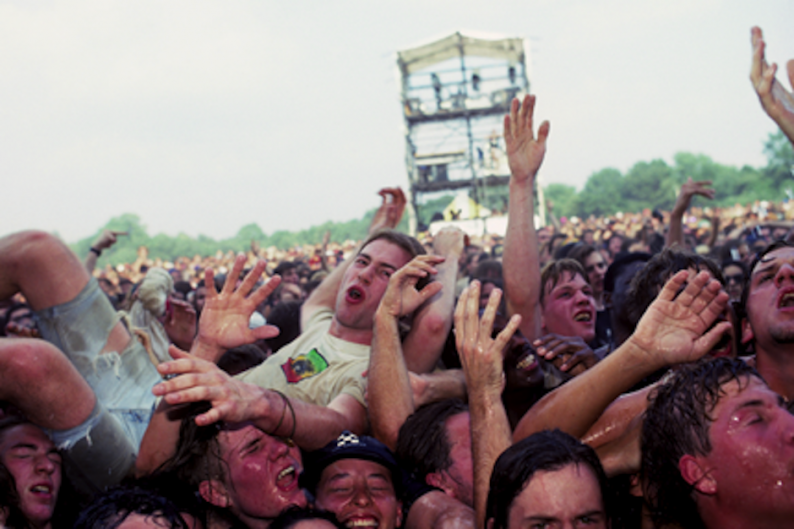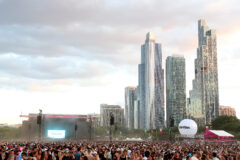BUDGIE: The tour was a blur until we hit Chicago and got a day off. That’s when me and our guitarist Jon Klein got arrested. We were in a bar and it was last call, you know, as they do in America, they say, “Remove your glasses now.” In England they don’t do that. You don’t grab people’s glasses off the bar. Next thing, Jon was on the floor, and there was a gang gathering around him. I caught someone in the mouth accidentally, and Jon had bitten someone on the shin. Within minutes we were both handcuffed and tossed into the back of a waiting police van. We were smoking cigarettes when they opened the door again, which we thought was very impressive, because our hands were cuffed behind our backs, but the police were not impressed. We thought it was the end of the tour for us, but no charges were pressed. We were bailed out the next morning and went back to the tour, and the guys on our crew and everyone else was like, “Heroes!” And the rest of the band were like, “Assholes!”
WORTH: In Cleveland there wasn’t enough security. The kids came from the lawn to the seats.
PATRICK: Everyone was excited to see a hometown band become this huge thing. I remember feeling so proud of being from Cleveland. I jumped into the audience and came out with nothing on. They ripped all my clothes off. All you see is my bare white butt getting back onstage.
NAVARRO: In the original Texas Chainsaw Massacre, towards the end, Leatherface is shot in broad daylight, almost as if you’re watching a documentary, and that makes it that much more terrifying. Just like Nine Inch Nails, seeing them in the daylight.
REID: We played New Jersey, and it was one of those shows where everyone was on point. The audience was so plugged into every band — it was the way a great concert is supposed to be.
FARRELL: I had found out that my mother was buried in New Jersey, not far from the venue. That night, I ate a tab of acid or so — I can’t remember how much. I felt that my mother’s spirit had to be close by. I never really told anybody that. I was singing for her and her friends.
REID: Perry had the holy ghost that night.
AVERY: By the end of the tour, I was playing regularly in four bands, just from hanging out and being bored and looking for something to do. I would go out and play guitar with Rollins. Buttholes: I’d come out and play drums. Nails: guitar. Then play with Jane’s.
BUDGIE: Mostly it was standing by the side of the stage watching. Once the sun had gone down, I remember fires being lit in the back of the show. It was crazy.
PATRICK: Every night I would crawl under the stage and pop up in that moat area with the security guards. I would have a six-pack of beer and smoke a little pot and sit there and watch Jane’s Addiction every night by myself with 20,000 people standing behind me.
Six weeks after it began in an Arizona heat wave, the tour wrapped up at rain-soaked fairgrounds outside Seattle. The final show offered the first glimpse of the Jim Rose Circus Sideshow, a parade of local punk-rock misfits whose gross-out humor and casual self-mutilation was soon closely identified with Lollapalooza’s outsider image.
JIM ROSE (founder, Jim Rose Circus Sideshow): We showed up, told a couple jokes, did a pierced weight-lifting thing — you could get a lot of mileage out of that then. Nobody had piercings. I didn’t realize the impact we had until a few days later. I was on the street in Seattle hanging up posters for my next show, and people kept coming up to me. It left a mark.
HAYNES: In Seattle, me and Perry went to the [Pike Street] market where there’s tons of shops and crap. Perry was just shoplifting at will, taking whatever he wanted. I followed behind and managed to pay for a few of the things. He was just so blatant about it, screaming through the store with that maniacal look on his face — wide-eyed, fucking high on who knows what.
JOBSON: We didn’t know if Jane’s was going to play right until the last minute. It was a bit of a weird, anticlimactic show.
If the first year was an experiment, the next six were a victory lap. Lollapalooza’s spawn — H.O.R.D.E., Lilith Fair, Warped Tour — targeted niches and hit them. As its popularity eclipsed its influence and the term “alternative rock” lost its meaning, Lollapalooza became a summertime rite of passage for American teens rather than a platform for innovation. The final Lollapalooza tour hit the road in 2003 with Jane’s Addiction, Audioslave, and Incubus headlining.
GARDNER: Originally, we had no idea we’d do it again the following year.
HAYNES: Lollapalooza was cool. A vindication, if you will. As far as musicians go, I think they value attention more than money. Instantly, managers, labels, bigger bands were pushing to get on the next year’s. When there’s a paradigm shift like that, there’s only a moment before what’s shifting gets absorbed into the bigger body.
ERNIE C.: It’s a piece of history that will stick because “-palooza” now is a part of everything. And in the 20 years since, I’ve never had that experience of camaraderie again. It was like one big band.
GEIGER: We started in ’91, and by ’96 underground music was over. Third Eye Blind was a cool band. Matchbox Twenty was the fucking next Radiohead.
ROLLINS: In America, or any consumer-driven society, anything that stands still long enough turns into a demographic and is marketed to. I can only speak for the first Lollapalooza, but I think it was very innocent. There’s no way the subsequent ones weren’t, in some way, calculated.
LYMAN: They couldn’t continue finding the cutting-edge newer bands. They made mistakes.
REID: What happened with Lollapalooza, and this is Perry Farrell’s genius, is it commodified “alternative,” simultaneously carving out a new market and ending it.
Reborn in 2005 as a multiday festival staged in Chicago’s Grant Park, the new incarnation of Lollapalooza features more than 100 bands. Former Chicago Sun-Times writer Jim DeRogatis calls it “Walmart on the lake.” Marc Geiger calls it “the Super Bowl” of music.
FARRELL: The first five or seven years, we would have the headliner be a fresh, new artist that could draw 20,000 people or so. Now we have to go back in time, further and further — we’ve got Paul McCartney playing [festivals], for crying out loud — because there aren’t breaking groups.
ROLLINS: A three-day festival, that’s cool. But it’s also ordinary.
GEIGER: Twenty years later, I think the product is so much better now and the experience is so much better now. I wish I wouldn’t have wasted time doing a touring model. I wish I had started Lollapalooza the way it is today.
AVERY: If Geiger had only done it in Chicago in ’91, we wouldn’t be having this conversation.





